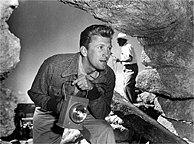Media Rules of Engagement
The following post is cross-posted from the Democracy Project, and is by Mediacrity contributor Bruce Kesler:
Those who argue that strict rules of engagement for our military forces are necessary to counterinsurgency, not to mention our core values, even when it means losing on the battlefield, have not applied near as much scrutiny to the rules of engagement by our major media.
The “fog of war” or “war is hell” defenses of troops at the front are dismissed by war opponents or armchair purists, but the same and worse is accepted from the major media. Yet, the major media operate under many similar foggy impediments but have chosen to be safer in the near and far rear, so they actually have less defense.
Both the military and the major media have rules of engagement, in the case of the media from journalism’s and their own organization’s standards. In many cases, although their defenders might argue as relatively few as among the troops, the major media have operated outside or against their rules of engagement.
Our troops are held personally accountable. Our media more rarely are. This isn’t just a matter of tit-for-tat or relative justice. It goes directly to the heart of the West’s ability to even wage war.
In war as waged by Western governments today, the homefront is at least as important as the battlefront, particularly when our homefront’s resolve is a primary target of the foe.
There’s a valid argument of experience that homefront support, and non-hostile media reporting and commentary, will follow from battlefield success. But, what’s missed is when the major media emphasizes the negative to the downplaying of the positive, in effect becoming adjuncts of the foe. The primary defense is the new media on the Internet, which while increasing in public counter-attention still is but a fraction of the major media’s reach and influence.
The current case of the Associated Press and its exclusive “Jamil Hussein” source is highly indicative. The stories spread by the Associated Press to its thousands of media customers around the world are highly suspect, and their primary source even moreso, but with little exception the AP’s customers have swallowed them and not demanded the AP live up to its rules of engagement. The evidence of the AP fouling journalism’s rules of engagement presented on the Internet are largely ignored or dismissed by the major media.
For a handy summary of the known facts, please see “The Latest & Greatest on Jamil Hussein.” Then, ask yourself how much of this you’ve seen in your local newspaper. Also, ask yourself how often you’ve seen in your local newspaper every rumor or allegation of our troops stepping over real or imagined lines of rules of engagement. Kinda a one-sided war, huh?
— Bruce Kesler
Those who argue that strict rules of engagement for our military forces are necessary to counterinsurgency, not to mention our core values, even when it means losing on the battlefield, have not applied near as much scrutiny to the rules of engagement by our major media.
The “fog of war” or “war is hell” defenses of troops at the front are dismissed by war opponents or armchair purists, but the same and worse is accepted from the major media. Yet, the major media operate under many similar foggy impediments but have chosen to be safer in the near and far rear, so they actually have less defense.
Both the military and the major media have rules of engagement, in the case of the media from journalism’s and their own organization’s standards. In many cases, although their defenders might argue as relatively few as among the troops, the major media have operated outside or against their rules of engagement.
Our troops are held personally accountable. Our media more rarely are. This isn’t just a matter of tit-for-tat or relative justice. It goes directly to the heart of the West’s ability to even wage war.
In war as waged by Western governments today, the homefront is at least as important as the battlefront, particularly when our homefront’s resolve is a primary target of the foe.
There’s a valid argument of experience that homefront support, and non-hostile media reporting and commentary, will follow from battlefield success. But, what’s missed is when the major media emphasizes the negative to the downplaying of the positive, in effect becoming adjuncts of the foe. The primary defense is the new media on the Internet, which while increasing in public counter-attention still is but a fraction of the major media’s reach and influence.
The current case of the Associated Press and its exclusive “Jamil Hussein” source is highly indicative. The stories spread by the Associated Press to its thousands of media customers around the world are highly suspect, and their primary source even moreso, but with little exception the AP’s customers have swallowed them and not demanded the AP live up to its rules of engagement. The evidence of the AP fouling journalism’s rules of engagement presented on the Internet are largely ignored or dismissed by the major media.
For a handy summary of the known facts, please see “The Latest & Greatest on Jamil Hussein.” Then, ask yourself how much of this you’ve seen in your local newspaper. Also, ask yourself how often you’ve seen in your local newspaper every rumor or allegation of our troops stepping over real or imagined lines of rules of engagement. Kinda a one-sided war, huh?
— Bruce Kesler


<< Home